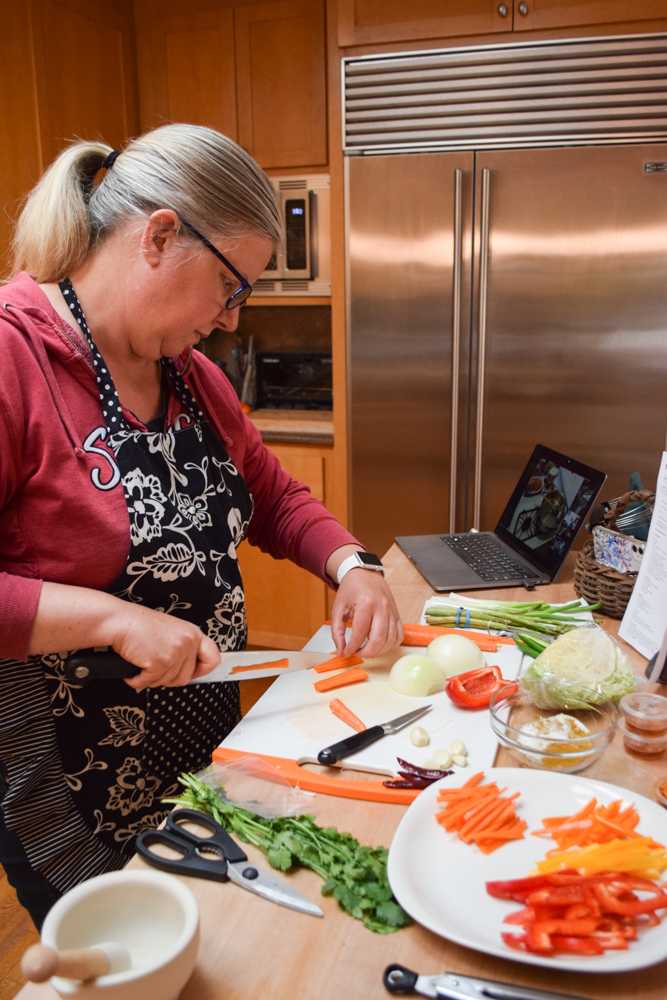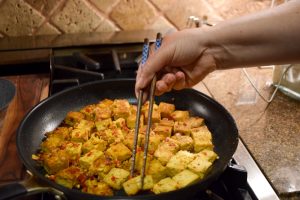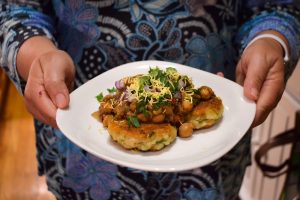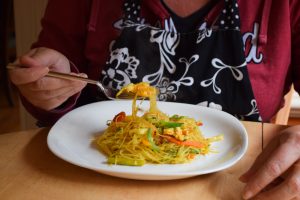Oil crackles and a spice-laden aroma sizzles to life as I flip small cubes of tofu in a pan. Behind me, my mom slices basil to top the dish we are preparing and laughs about how we almost ruined the meal at least three times. The rhythmic chopping of her knife and the sputtering of the frying pan are accompanied by chatter and instructions from the computer propped up at the corner of our counter — blending into a kitchen cacophony.
Over Zoom, cooking class instructor Ashvee Kanwar has guided me and my mom, as well as our fellow cooking class participants, through preparing delicious vegetarian dishes from lemongrass tofu to pav bhaji. Hers is one of many online cooking classes that have popped up during the pandemic to satisfy people’s desire to diversify their dining options even with so many restaurants shut down.
Ever since my mom signed us up for our first Nibble n’ Gobble cooking class in January to add something new to our quarantine routine, cooking Zooms have become something of a Sunday tradition.
Each cooking class experience starts in a somewhat unexpected way: with a trip to the park. A small grassy lot in Mountain View serves as the distribution location where Kanwar sets up shop to pass out the goods needed for each week’s meal. The convenience of the pick up system allows for my family to indulge in ingredients we generally don’t have stocked up in the fridge, since Kanwar aims to include dishes from many countries and cultures.
“We were all stuck at home sheltering in place,” Kanwar says. “The idea was to travel via your plate.”
“We were all stuck at home sheltering in place… The idea was to travel via your plate.”

— Ashvee Kanwar, cooking class instructor
Later in the evening, a group of around 15 families log onto Zoom and get to chopping, mixing, grinding and frying. At this point in the pandemic, most everyone has adapted to virtual events, and while off-hand chatting isn’t quite what it would be in an in-person setting, the class runs smoothly with a constant stream of questions and directions.
“I was a little skeptical about making connections on Zoom, but it has worked so well,” Kanwar says. “We have a little community going now. … There are a couple of families who have been cooking with me right from the beginning.”
If there’s ever a lull in the conversation, Kanwar steps in to share the history of the dish — like how Singapore noodles originated in Hong Kong — or to tell us about her personal experience with the food from her travels.
Anything that may be lost in community small talk is more than made up for in my laughter and discussion with my mom. From the safety of our own kitchen with our microphone on mute, we are free to make numerous mistakes and laugh at our culinary incompetence without embarrassment.
And yes, we have certainly made our fair share of mistakes. With sauces mixing, veggies sautéing and tofu marinating, it is all too easy to get a little lost. A cooking class presents the problem of keeping up as, unlike a video tutorial, there is no pause or rewind button, and unlike a recipe, things keep moving, even when you don’t.
For example, when Kanwar told us to add the rest of our coconut milk to our Kerala veg stew, my mom and I turned to each other wide-eyed with the realization that we had added all our coconut milk as part of the first step.

With every mistake — from the simple to the more serious — Kanwar was there to reassure us our dish would survive or walk us through some emergency operations. But while our problems were varied, the one constant in all of our errors was that they were followed by howls of laughter. And that above all is the joy of cooking — second only, perhaps, to the joy of eating.
The 90-minute classes end with smiling faces and waves goodbye before closing the computer lid and digging into the beautiful plate of steaming food sitting in front of you — that is, if you have more patience than me and haven’t already been stealing bites for the last 20 minutes.
While Kanwar misses seeing people’s live reactions to tasting their food and eating as a group, she notes that the at-home element has quite a few benefits and plans to continue the online class post-pandemic.
“They [class participants] are making it all by themselves, that gives them the confidence of handling the ingredients, asking questions, using all their senses to actually experience what they are making and then sharing the meal with their family,” she says.
Sitting down with my family at the end of a class and sharing the stories she told and the food we made makes for a bright end to the weekend. And in a year where monotony has become the norm, these delicious dishes and the experiences that come with them add spice to our recipe books and our days.
Lemongrass tofu with cucumber saladSoft and nutty, the tofu strikes a harmony of lemongrass, garlic and chili combining into a gentle overall taste. The onions and shallots lend depth, having soaked up the rich flavors more so than the tofu. As a complement and contrast, the peanuts add crunch to the otherwise soft textures, while basil brightens the dish. The cucumber salad opposes the warmth of the tofu with a bright, zingy and cooling flavor profile. Cilantro, mint and scallions each contribute a sharp flavor complementing the crunch of cucumber, bringing this dish to life. The bright lemon and cilantro balance the light saltiness and the peanuts allude to the flavors of the main course, creating a beautifully harmonious meal. |
 |
 |
Aloo tikki choleThis dish is a culinary work of art with layers of flavors and texture from aloo tikki, chole, sweet chutney, mint chutney, red onions, cilantro and sev. The disk-shaped, spice-laden potato base of aloo tikki serves as a hearty ground to the meal with a light crunch and a soft, warm inside. The warmth is accompanied by a gentle but noticeable heat from the myriad spices of the chickpea curry called chole — accented by the punch of sweet chutney. On top, red onions and cilantro bring the freshness demanded by the heavier potato base. |
Singapore noodlesThis dish is defined by the strong curry punch of the noodles, making your choice of curry powder a crucial step. Colors abound with carrots, bell peppers, eggs, asparagus, and cabbage folded into the dish, while turmeric and the aforementioned curry powder lend a bright yellow hue to the rice noodles. A finishing touch of jalapeño, chili oil and sambal oelek chili paste is a must to add an exciting depth of flavor to the plate. These noodles are warm and satisfying without too much spice, making for a fun and accessible comfort food for families with pickier eaters. |
 |



